- Cisco Community
- Technology and Support
- Service Providers
- Service Providers Knowledge Base
- ASR9000/XR Using and understanding BNG GEO-Redundancy
- Subscribe to RSS Feed
- Mark as New
- Mark as Read
- Bookmark
- Subscribe
- Printer Friendly Page
- Report Inappropriate Content
- Subscribe to RSS Feed
- Mark as New
- Mark as Read
- Bookmark
- Subscribe
- Printer Friendly Page
- Report Inappropriate Content
04-17-2016 05:43 AM - edited 01-29-2019 08:04 AM
Introduction
Geo redundancy is a powerful new technology for XR BNG that allows for session synchronization between 2 nodes. This means that a session active on one node has a shadow and fully programmed session on a standby node, so that when the active chassis fails, the standby BNG can take over and continue to forward the session info WITHOUT service interruption to the user.
Geo redundancy overcomes some of the restrictions that other redundancy models have which makes it a solution that is very compelling.
Existing redundancy models
Some of the existing models include the use of PPPoE smart server selection, ASR9K nv Cluster, ISSU, MC-LAG/MSTAG. This section outlines their operation and pros/cons.
Smart Server selection
Smart server selection relies on the operation whereby a host sends a PADI (discovery), which is broadcast to multiple devices/BNG's. Normally all hosts send a PADO (offer) back to the client who then connects with one of the offered BNG's for a single connection. By controlling the response time of the PADO's from all BNG's we can make one node more primary for a particular vlan, and the other(s!) standby.
The solution is stateless, meaning that if the active node dies, the client needs to rediscover and will find one or more stadnby BNG's for connection with.
Pro is that this is simple, useful, it provides N+1 redundancy (multiple BNG nodes can be used on the segment for more sharing of the load).
Con is that this is stateless, clients have to reconnect, per vlan bases and for PPPoE only (not usable for dhcp). Though a similar concept can be leveraged for IP sessions by delaying the offer timers of the dhcp server.
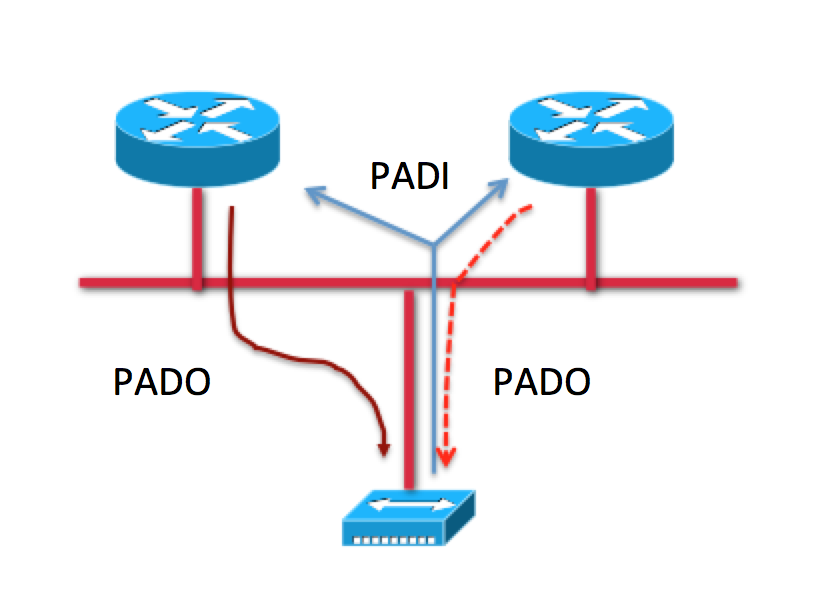
nV Cluster
Clustering two devices by linking their brains together via what we call the EOBC (Ether out of band connection), makes two chassis become a perfect mirror from each other. This automatically means that you have stateful redundancy.
It relies on the fact that you are dual homed with a connection in both both racks of the cluster. If the cluster device or rack we call it, fails the other chassis will take over as sole primary and the forwarding over the bundle all happens without any disruption
Pro: powerful, stateful, high scale
Con: sw upgrades, hw restrictions for cluster, requires bundle intefaces and dual homing into both nodes of the cluster, costly/license
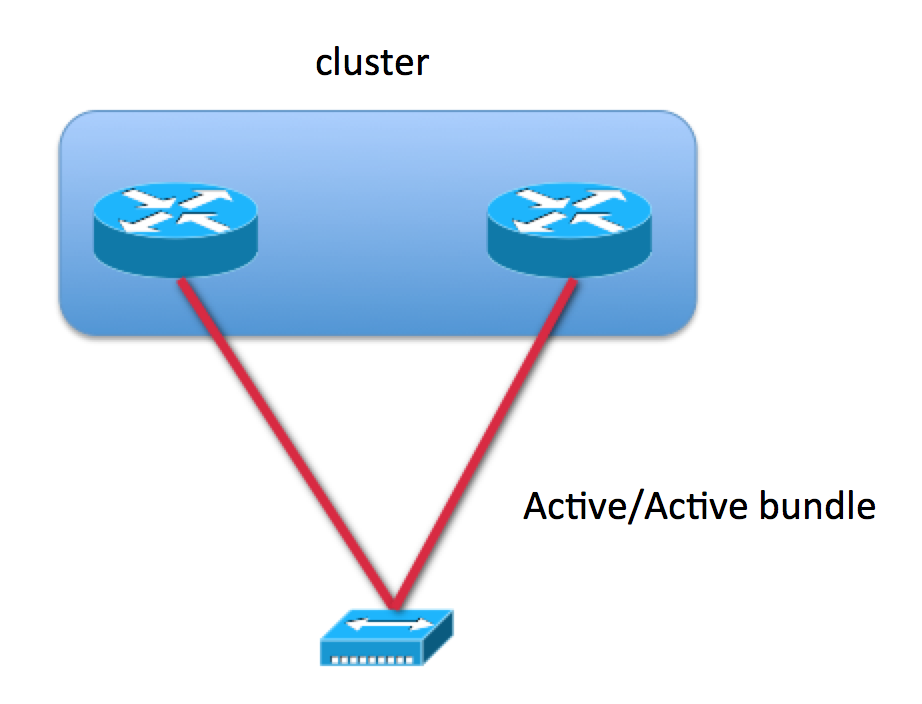
MCLAG/MSTAG
Using standard redundancy technologies like mclag or mstag provides for a lot of simplicity. These technologies allow for dual homing and relying on ICCP (mclag) or STP (MSTAG) protocols to detect loops and only have one active link forwarding.
This means that a session is only available and active on one node at the time.
Pro: very simple low cost
Con: long convergence times and stateless
Summary
How nice would it be to have the best of all these solutions and not having so much cons? That is where GeoRed comes into play :)
How to use GeoRed
Geo redundancy provides for a very powerful M:N or N+1 redundancy model depending on how you like to implement it.
Flexible redundancy models via pairing across routers on Access Link basis
- 1:1 (both active/active with load sharing or active/standby) (like nv Cluster)
- M:N (active/standby roles and load is split across multiple routers)
- N:1 (1 backup for N active)
Full circle standby (M:N)
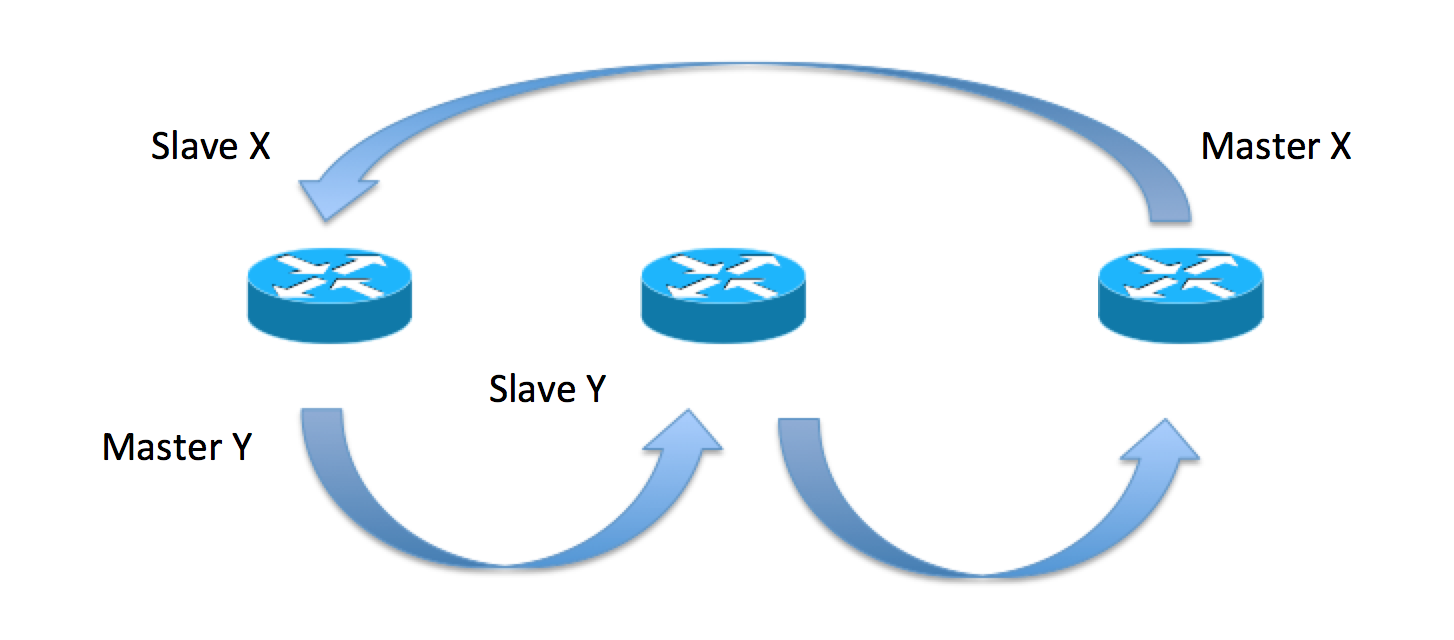
Designated backup (N:1)

There is no special connection required between the BNG's, just an ip connectivity for the redundancy protocol (to be discussed later).
One big advantage is also that the different BNG nodes may be placed in different geo-locations without any limitations!
Complements existing BNG high-availability, redundancy and geo-redundancy mechanisms.
Geo redundancy in a nutshell:
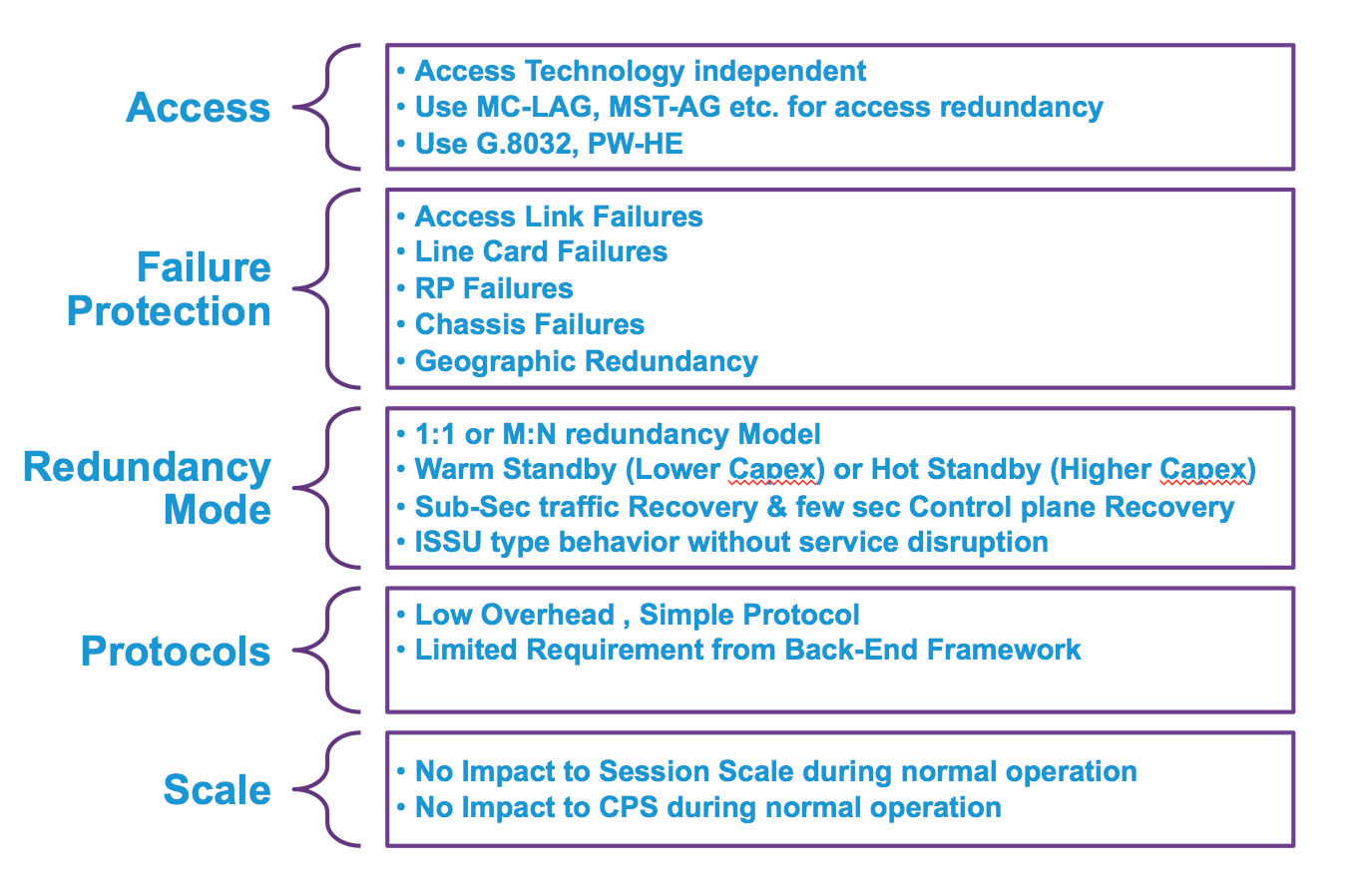
A typical design could look like this:
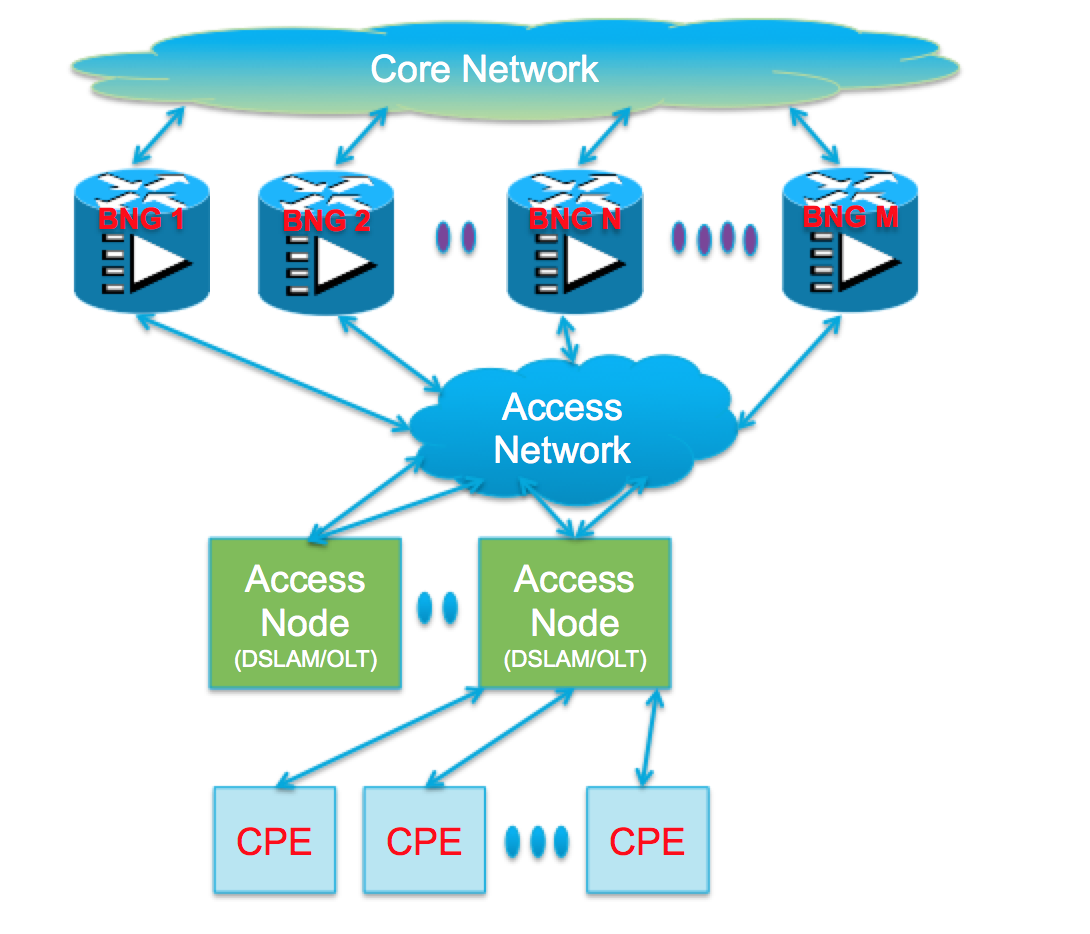
CPEs are agnostic to redundancy and they see “one BNG / Gateway”. Any switchover is transparent to them. With the redundancy model used, the CPE peers with the same mac address and node ID hence if a failover is required the CPe doesn't even know that it is talking to a different physical device.
Access Nodes are dual/multi-homed for redundancy using a variety of technologies such as MCLAG, Dual Homed (MST-AG), Ring (MST-AG or G.8032), xSTP, Seamless MPLS (PWs), etc. Using heartbeat mechanisms like E-OAM, BFD, etc. for faster fault detection/isolation.
BNG is not just a gateway router, it has subscriber state, policies and accounting/authorization details and subscriber features. Redundancy and synchronization also require sharing of protocol state like DHCP and PPP.
A good redundancy solution also should employ seamless integration with external servers like DHCP/Radius and backend policy/billing systems.
Implementation details
The concept for geo-redundancy is built on top of a sync protocol that is used in MCLAG also: ICCP (inter chassis communication protocol). It is a reliable protocol that allows for state and info sync between 2 chassis.
One of the basic pieces to that is the definition of what we in GEORED will call the Subscriber Redundancy Group (SRG).
Taking the picture from above, that shows the M:N or N:1 redundancy topologies, an SRG is the equivalent of the "X" or "Y" arrows:
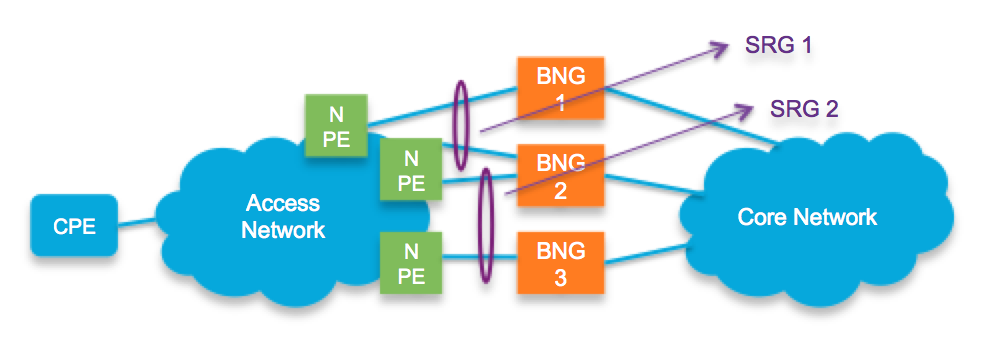
Synchronization
Synchronization from “master” to “slave” is done over TCP on per SRG basis between routers using proprietary mechanism – BNG Sync
This mechanism serves the following purposes:
- Signaling failures and role changes
- Synchronization of subscriber sessions’ control plane states
- Communication of other events and commands
When BNG SRG peers connect, first the master slave determination is done, after which sync of state happens from master to slave followed by regular mirroring that happens without delay with without holding up the session provisioning on master.
Session mirroring takes care of complete state once the session is up; and when there is any change or when it is deleted
Roles
Master/Slave roles are defined by the SRG and not defined as a BNG router by itself. This simply means that SRG1 can be active on router ONE and SRG2 will be active on router TWO, and SRG1 will be standby on router TWO also.
active/active – (eg the M:N) BNG could be master for one SRG and slave for another
active/standby – (eg the N:1) dedicated backup BNG could be slave for multiple SRGs from different active BNGs which are masters for those respective SRGs
Role negotiated via BNG sync between routers on per SRG level
Where possible, role can be determined by the underlying access technology
In master role BNG will handle and process all control traffic it receives
In slave role BNG will ignore all BNG and related protocols traffic. It will receive state notifications of the session via the ICCP communication from the active node serving that SRG.
Modes of operation
GEORED can operate in two distinct redundancy operations. That is hot and warm standby.
Hot-Standby Mode (default)
Sessions provisioned on slave in sync with setup on master
Since the sessions are actively programmed on the standby, this will consume hardware resources on slave. Proper planning is necessary here, since if we have BNG node X and Y both serving 50k sessions each, the slave node needs to be able to support 100k sessions when they are actively programmed!
Minimal action on switchover; data plane is already setup for sub-second traffic impact, this is the highest level of redundancy you can achieve.
And especially useful in deployments requiring high and tight SLA
Warm-Standby Mode (for over-subscription)
Sessions data kept in “shadow” database on slave in sync with setup on master
Only consumes some additional memory in control plane for the shadow copy – no provisioning in hardware
Upon failover trigger, sessions are setup at rapid pace from shadow copy
This allows for over provisioning on backup for subscribers. While it still provides for a high level of redundancy, and the "outage" or forwarding loss is determined by the time it takes to hw program the sessions served by the SRG, the failover will result in some session loss (if the SRG serves high number of sessions that take longer to program then the keepalive/timeout of the session).
Session distribution
Example scenario with an active/standby, N:1 model:
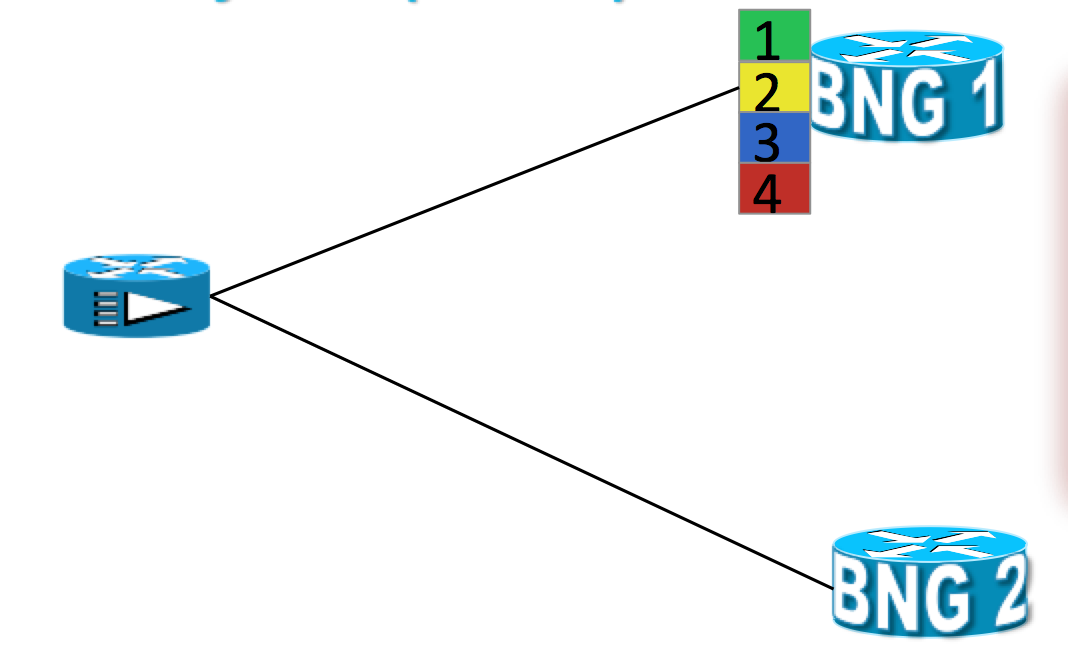
- Sessions are associated with partitions (vlan 1,2,3,4) on BNG1 with each VLAN mapped to different SRG configured with master role
- BNG2 IS acting as backup for all VLANs
- Each VLAN has 8k sessions terminated
Example scenario with an active/active, N:1 model:
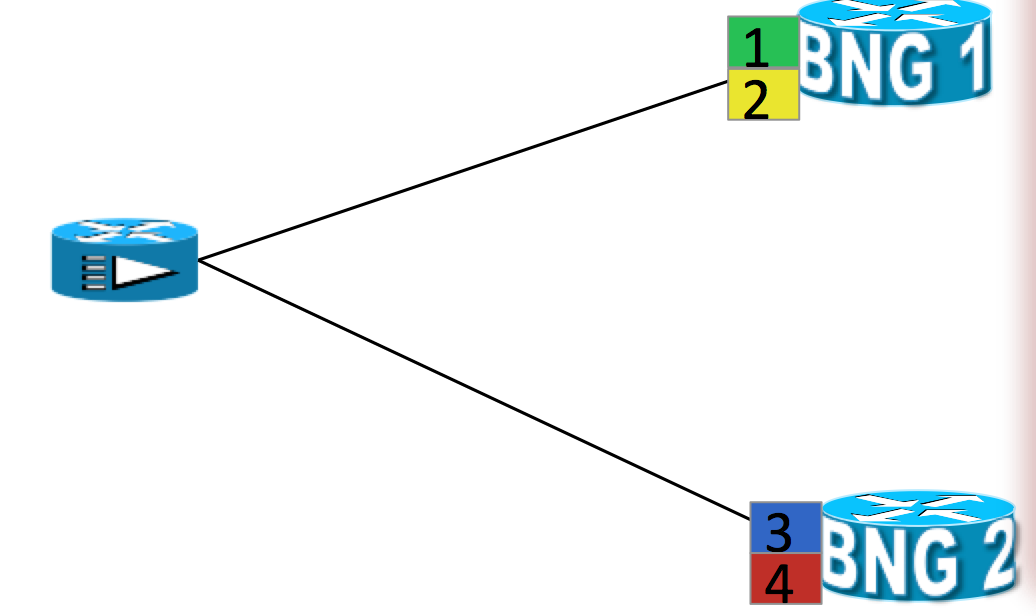
- Sessions are associated with partitions (vlan 1,2) on BNG1 with each VLAN mapped to different SRG configured to Master role
- Sessions are associated with partitions (VLAN 3,4) on BNG2 with each VLAN mapped to different SRG configured to Master role
- Each VLAN has 8 sessions terminated
- Each BNG has 16k session terminated
Radius Interaction
some important notes regarding radius accounting and authorization information
- Authentication/Authorization done only from the Master and all profile information is syncd to Slave. Slave does not reach out to radius and relies on the session information received from the active node.
- On Failover, Accounting Stop message is sent from old Master and Accounting Start from New Master.
- NOTE: Accounting Stop from old master sent on best effort basis and ordering is not guaranteed between it and the Accounting Start sent by the new master. A failover session should be handled as two separate sessions by Radius
- Radius (Accounting) messages from BNG are paced with jitter (especially around switchover) to avoid load on the server
Managing upgrades
One of the big advantages of GEORED that overcomes a painpoint of nV cluster is the sw upgrades.
In cluster, an orchestration is necessary to separate the cluster nodes, upgrade one and make a quick switch over to upgrade the other one.
In Geo Redundancy, the BNG nodes can run different sw versions even! and that is no problem. Although we wouldn't recommend too much version disparity between the devices and for the ease of deployment have all BNG nodes in the network, regardless of being part of the GEORED to be on the same sw version as much as possible with the same smu set.
The SW upgrade procedure would be opaque to the redundancy model chosen (N:1, M:N, active/active or active/standby).
Basically the steps include:
- Failover SRG's one by one running active on the BNG node to its standby
- If hot standby, step "1" will be quick. If warm standby allow for some time for the sessions to be programmed
- upgrade the BNG to the desired sw level
- pull back all sessions for the SRG's that need to be running active on this BNG
And do this for all the BNG nodes part of the SRG interaction.
NOTE: you can even setup GEO red just for the upgrade procedure. A node that is synchronizing its sessions during this setup is not affected whatsoever.
Session set up and call flow details
The following section graphs out the call flow and messaging between BNG SRG devices and the session.
Initial Session Setup
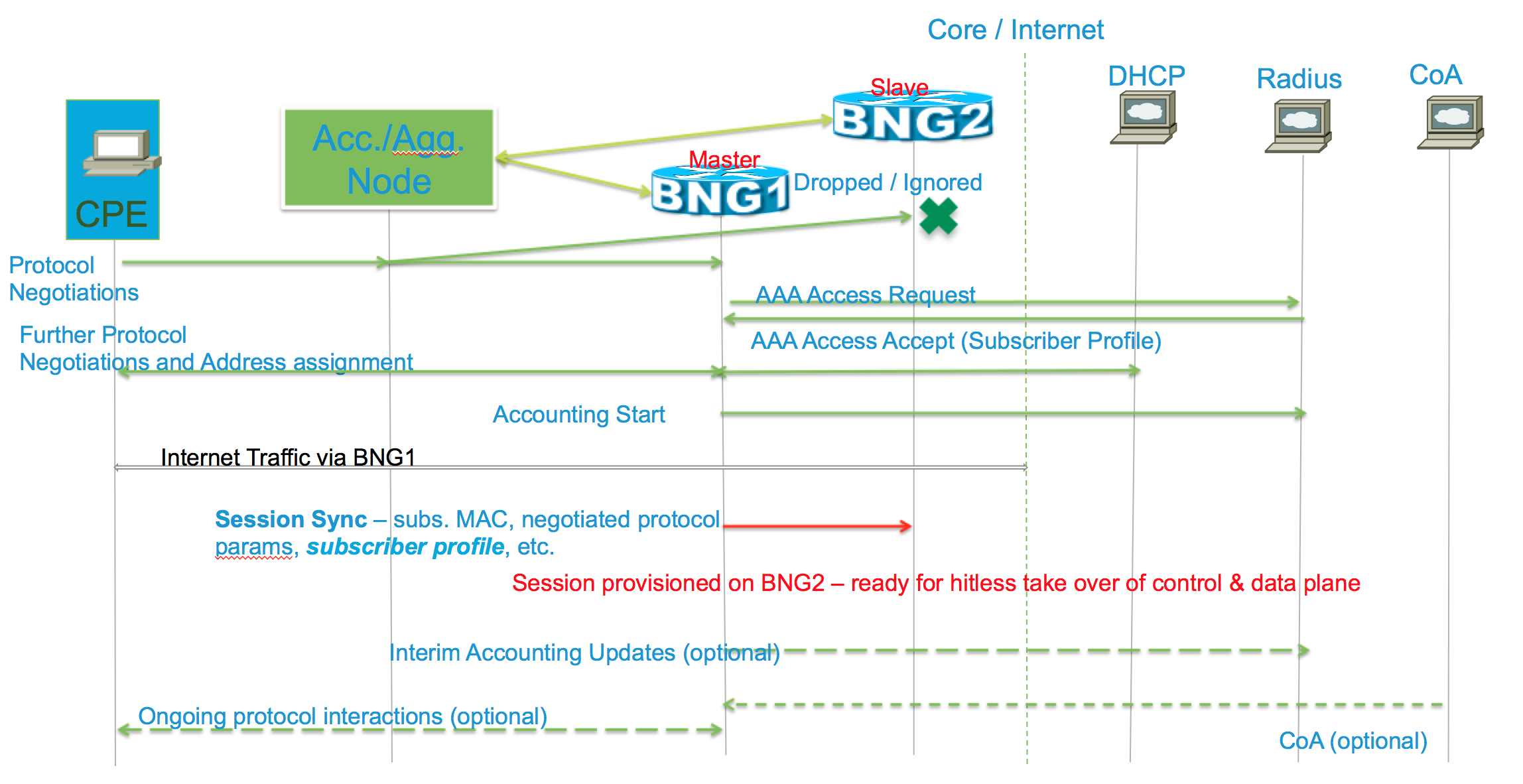
- Only Master does Radius/Policy server interactions for the subscriber using its NAS IP, NAS Port and accounting session ID
- In addition to protocol state, subscriber profile (including any further changes as result of CoA) are sync-ed across from master to slave
- Slave sets up the same subscriber with a different accounting session ID – it has different NAS IP and likely different NAS Port
- Redundancy design and Slave is invisible to Radius/policy server before the switchover. That is the radius/PCRF have no awareness of the fact that a session is synchronized.
Failure scenario
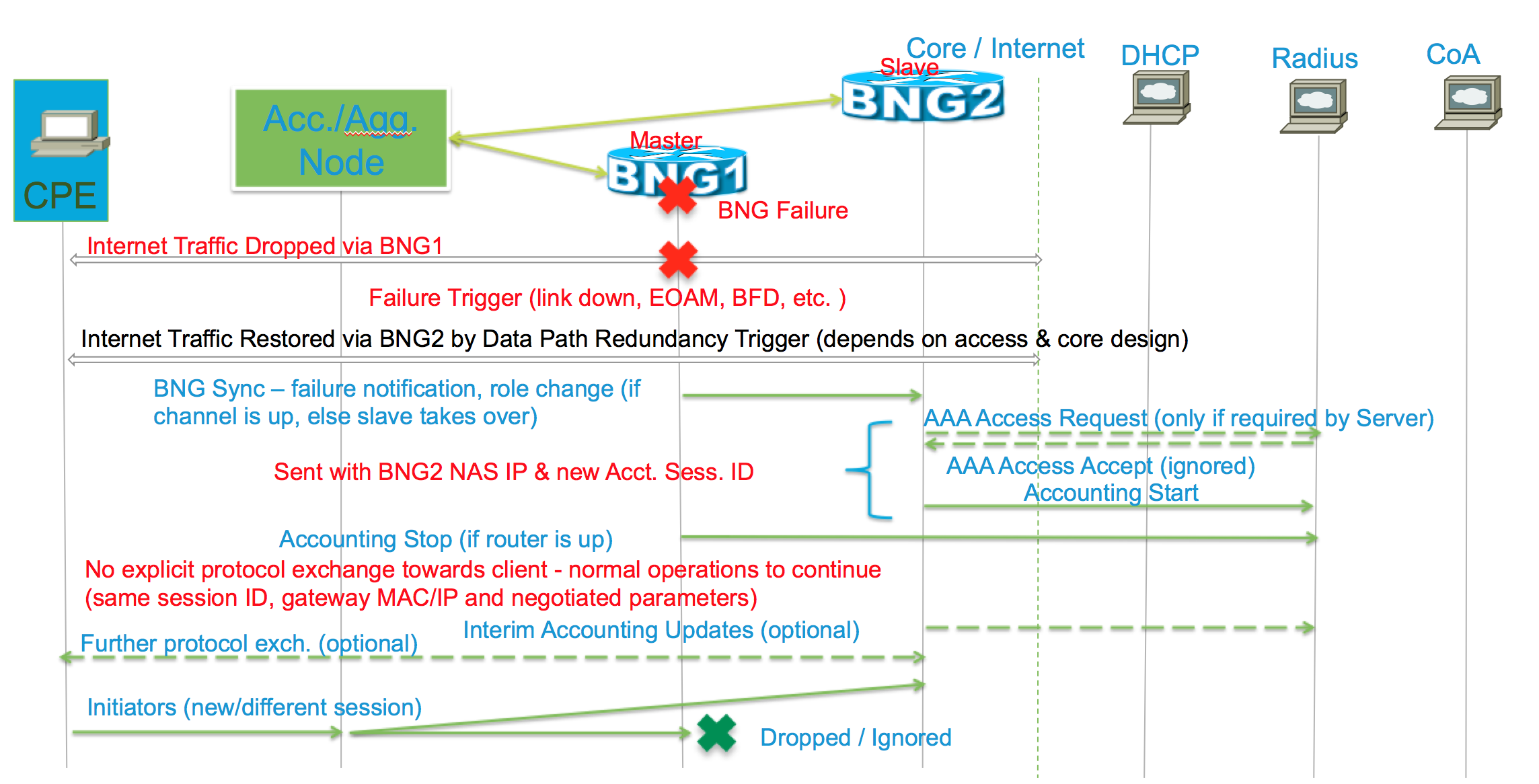
- Subscriber already provisioned on slave and ready to forward traffic even before switchover; Loss on fail-over depends on Access network failover or convergence
- Core network design – fast reroute, BGP PIC, core convergence
- BNG Sync channel used to signal failures and trigger switchovers between BNG routers; this is control plane sync.
- Accounting updates – start/stop/interims
- DHCP state machine on slave takes over without any client/server interactions
- Lease will continue on slave from when master started it
- PPPOE/PPP state machine on slave takes over from where master left without any client impact
- PPP keep-alive will start flowing from new master on takeover
Use cases
MSTAG
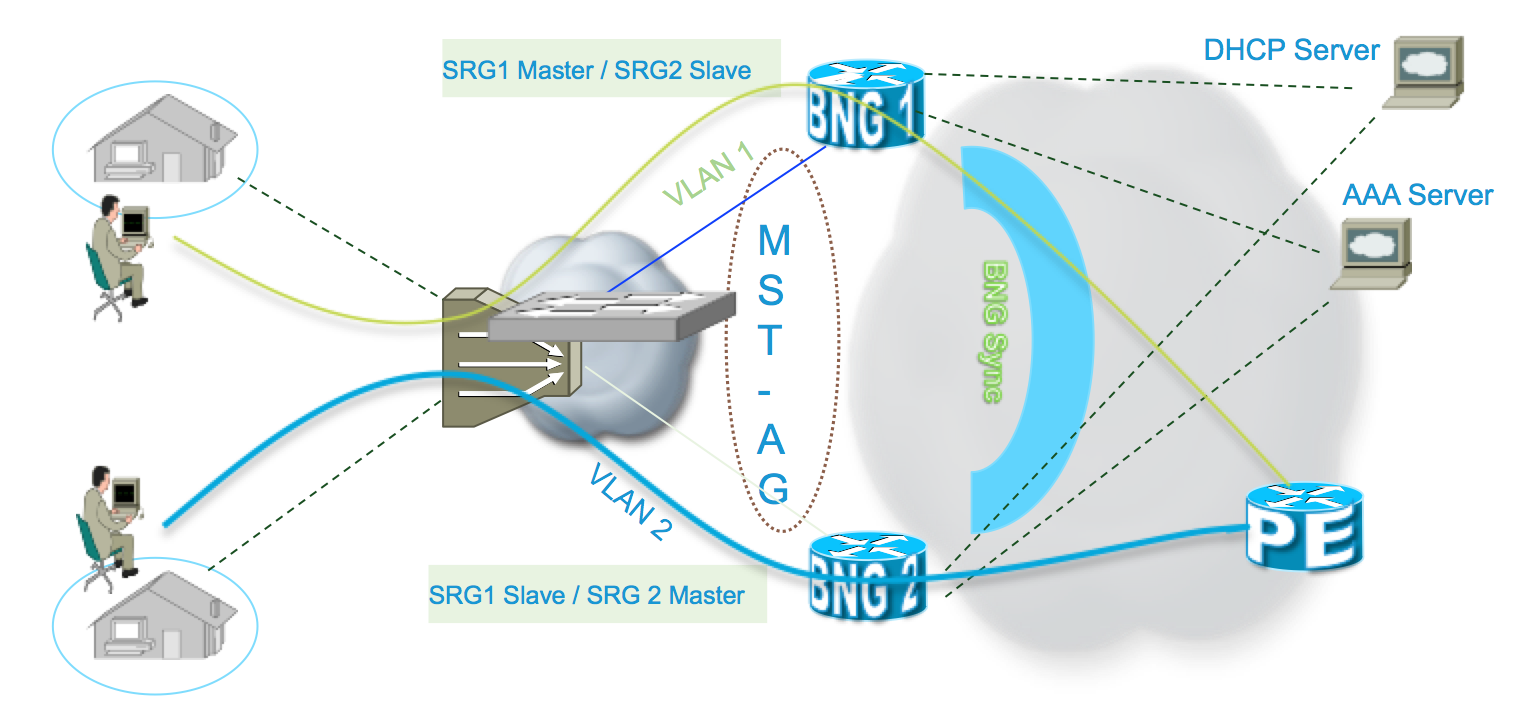
The MSTP protocol is used here to block standby path so we have only one active
In this case each BNG have their own MAC which is used for MST and other Ethernet protocols. In this scenario we need to setup SRG vMAC for BNG sessions. Which will act like an HSRP/VRRP virtual mac in the same facinity. The BNG's use their own mac for the STP communication, we'll use the vmac towards the sessions as their peering/communication point.
For dual homing two MST instances required with VLANs split across them to enable active/active load balancing to each of the 2 BNGs
MST provides “preempt delay” knobs to throttle switchovers and allow stabilization of subscribers on top of it after failure recovery.
Failure detection, or the improved detection for it is done via CFM sessions (at least one per MST instance in any of its VLAN). The CFM session is used to monitor connectivity and to detect which BNG has the forwarding path and which one has the standby/drop path (i.e. CFM session will be UP on active & DOWN on standby)
Coupling the CFM session via EFD with each of the BNG L3 access sub-interfaces on that interface will result in that sub-interface status tracking UP on active side and DOWN on standby side.
Access tracking object monitoring this sub-interface status (which is in turn controlled via EFD based on CFM session) is used for determining SRG role as well as controlling the subscriber subnet route advertisement
In event of failures, as MST re-converges and switches paths, the CFM session status changes and the L3 BNG sub-interfaces get notified of status via EFD such that the SRG role can be switched
MST and CFM timers can be as aggressive as supported by the access devices with stable operations even with full subscriber load
MCLAG
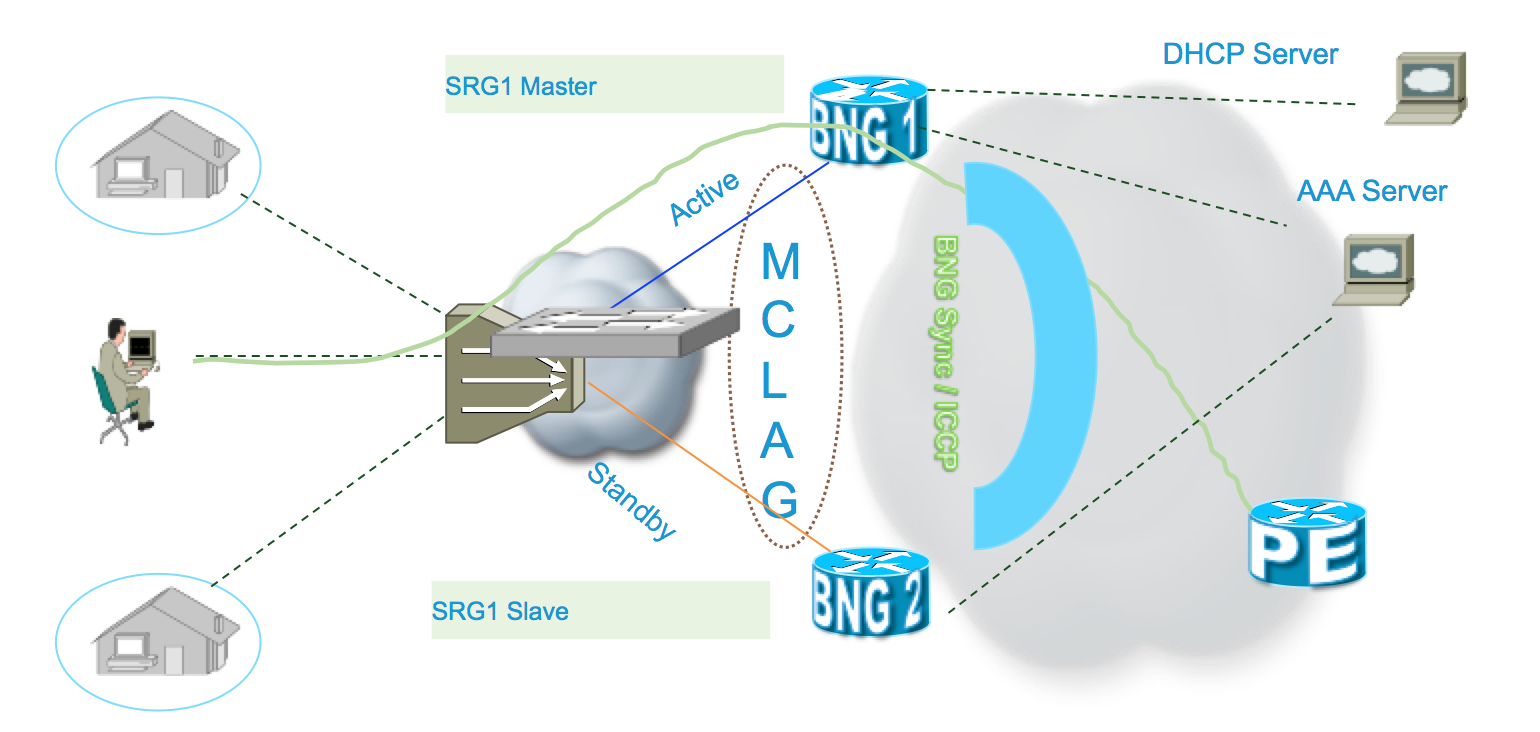
MC-LAG provides consistency of MAC and IP address across the two PoA (i.e. BNG routers). In this scenario there is no need for SRG vMAC since it is managed by MCLAG natively already.
The failure is induced by an object that directly tracks MC-LAG bundle interface status and signals to both SRG (for role determination) & the routing entity (to control the subnet/pool advertisement).
MC-LAG provides knobs to throttle switchovers and allow stabilization of subscribers on top of it in event of link flaps and after failure recovery
Parameters to consider when using MCLAG:
mlacp switchover recovery-delay – to ensure bundle remains slave after recovery from failure and allows subscribers to get sync and stabilized on it in slave mode
mlacp switchover type revertive – means that when the primary comes back, it will assume the primary role also and basically pull everything from the standby back. Like HSRP preempt.
lacp switchover suppress-flaps – to avoid switchover for transient link-flaps
BFD or CFM with EFD can be used for faster detection of failures in addition to LACP protocol mechanisms
LAC
Configuration and setup
Now that you know everything about GEORED you want to go set it up right?! Here is a config piece and explanation what it is for.
| Enable BNG GEo Redundancy |
group 1 peer 1.1.1.1 |
|
Set up SRG and define which group holds which interface. Multiple groups can be defined. |
subscriber redundancy group 1 interface-list interface bundle-ether1 id 1 |
|
Setup Access Object Tracking for SRG and Summary Subscriber route. In this example we are tracking the interface bundle state that MCLAG is providing to us. If we see that the state is going down, that will result in a static route withdraw from the table. If we have redistribute static configured, the pool summary will be removed so that the previous standby, now active can start advertising the summary to start pulling the traffic. |
track access-mclag type line-protocol state interface bundle-ether1 subscriber redundancy group 1 access-tracking access-mclag router static address-family ipv4 unicast 10.0.0.0/24 null0 track access-mclag desc sub-pool-summ |
| Optional SRG configuration to determine more deterministically what the preferred role is and what redundancy mode should be run. |
subscriber redundancy preferred-role master slave-mode warm hold-timer 15 |
A little more detail of the subscriber redundancy configlet
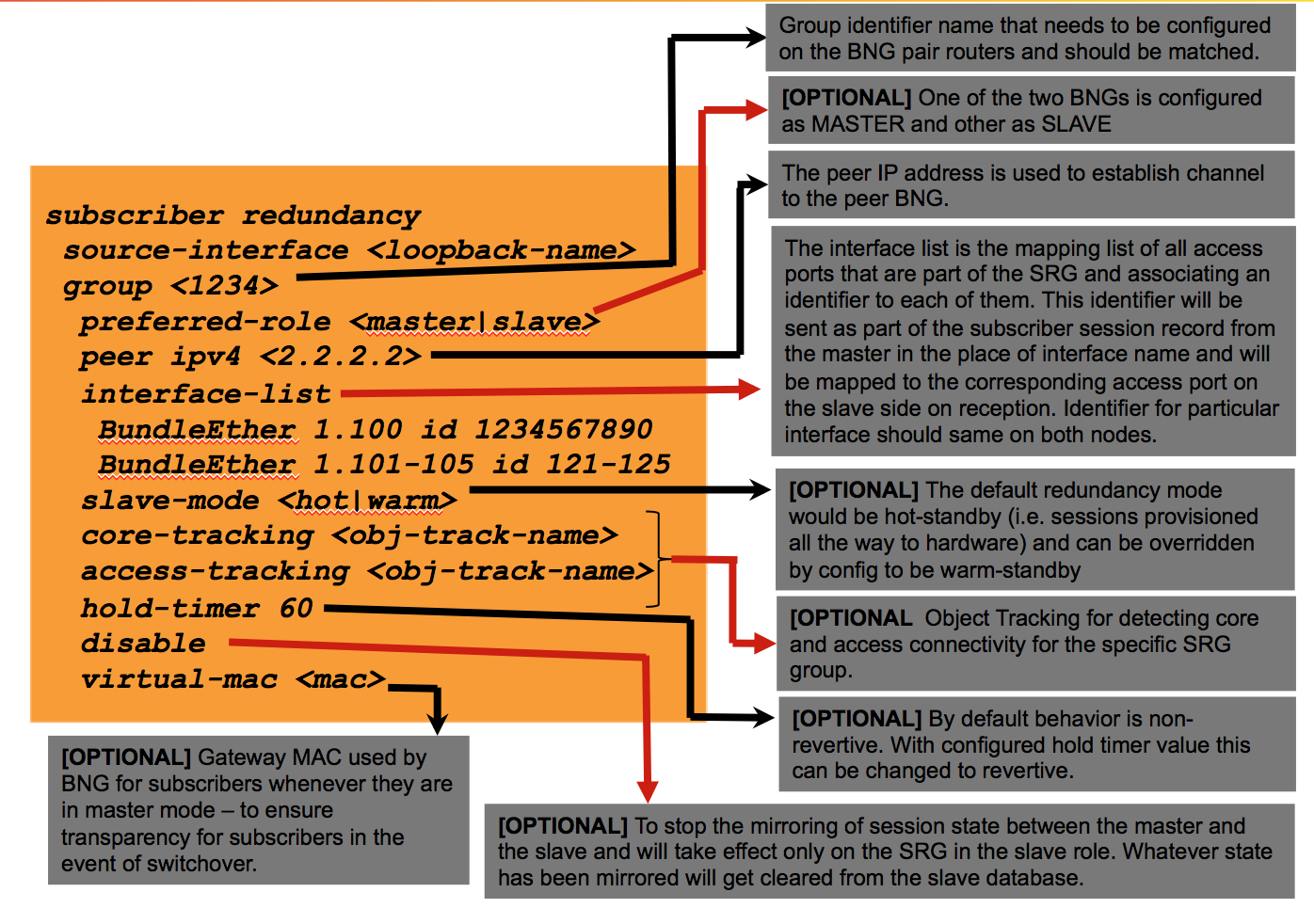
Restrictions and limitations
As with everything in technology, there is always some trade off. This table below is what exists currently as know restrictions for the GEORED solution as of XR 5.3.3
Note that XR6 has quite a significant amount of improvements, that will be documented separately. Since XR 5.3.3 is the going release today for ASR9000 I thought it is important to know what you get and where you need to think about.
|
Limitation |
Recommendation |
|
With just Core tracking, if core interface goes down, SRG switchover is triggered causing traffic black hole on access |
EEM script can be used to shut access when core goes down |
|
RA will send with both SRG vMAC as well as interface MAC towards access |
use RA preference CLI under dynamic template or access-interface |
|
Accounting records may get lost if we do back-to-back switchover before they sync on master and slave |
we should wait for 15 mins before doing Switchover (128k sessions) |
|
Admin clear of sessions from the slave is prohibited |
1. If slave is out of sync from master, subscriber redundancy synchronize command can be issued from slave to replay
2. SRG clear command can be issued either from slave or Master to get slave back to normal state |
|
Master reload is not recommended on the access with non-revertive protocol support |
Enable revertive configuration on the access-protocol |
|
On flight vmac modification for IPv6 sessions is not supported |
Features not supported:
- Static subscriber
- DHCP Routed subscriber
- Packet trigger Sessions
- Multicast on subscriber and Qos Correlation
- SLAAC for subscriber
- BNG as DHCP server
- IPv6 ND as SRG client
- Diameter & Geo-redundancy interworking (6.2.x)
XR6 enhancements details
Miscellaneous
With great thanks to the GEORED dev team for some of the visualizations used in this paper.
PS. it is highly important not to use pppoe bba-group Global. This is a reserved keyword that is known to break certain SRG cases. name your bba-group to anything but global/Global.
- Mark as Read
- Mark as New
- Bookmark
- Permalink
- Report Inappropriate Content
Thanx Aleksandar
We are performing PPPoE termination on Bundle-Ethernet.
In our case we shall have single homed NVs. Specifically the active GigE interfaces will be connected directly to ASR9k_1 and the back_up GigE interfaces connected to ASR9k_2 through single homed NVs (they shall be only connected to ASR9k_2)
So we shall have for each DSLAM one MC-LAG bundle interface with two GigE members
(The first connected directly to ASR9k_1 and the second through single homed NV to the ASR9k_2)
I do not now this difference in the two GigE participating in the MC-LAG (first directly connected to the ASR, second connected through NV to the other ASR9k) will have cause problems in Georedundancy
Best Regards
Vikas
- Mark as Read
- Mark as New
- Bookmark
- Permalink
- Report Inappropriate Content
hi Vikas,
The beauty of BNG Geo-Redundancy solution is that you don't need MC-LAG between the two ASR9k_1 and ASR9k_2. The BNG Geo-Redundancy control plane will decide which of the two ASR9k will be Master or Slave for a given SRG. This simplifies significantly the design.
/Aleksandar
- Mark as Read
- Mark as New
- Bookmark
- Permalink
- Report Inappropriate Content
This setup is very interesting (MC-LAG / MSTAG not being prerequisitives for GeoRedundancy to work). Is this an upcoming feature?
For the NV we shall try the topology with mlacp with the two_links
DSLAM_Link1 => ASR_1.G0/0/0/0 => ASR_1.Bundle1
DSLAM_Link2 => NV_Satellite.G0/2 => ASR_2.Ten0/0/0/0 (ICL link) => ASR_2.Bundle1
Hope it works.
- Mark as Read
- Mark as New
- Bookmark
- Permalink
- Report Inappropriate Content
hi Vikas,
"BNG GEO-Redundancy" is a very specific feature that was introduced recently to provide flexible redundancy solution for BNG. This is what Xander describes in this document. With XR release 5.3.4 you can already make use of it.
Apart from this document, you can also read about it in the 5.3.x BNG configuration guide:
https://www.cisco.com/c/en/us/td/docs/routers/asr9000/software/asr9k_r5-3/bng/configuration/guide/b-bng-cg53xasr9k/b-bng-cg53xasr9k_chapter_01110.pdf
Please use XR release 5.3.4.
/Aleksandar
- Mark as Read
- Mark as New
- Bookmark
- Permalink
- Report Inappropriate Content
Hello Alexander,
I keep seeing MC-LAG or MST in "Deployment Models", and also this statement in config guide:
"You must use only those dual-homing techniques where one side is up or active, and the other side is down or standby. Both sides must not be up and forwarding traffic at the same time."
but had a feeling we can live without them, because Slave is supposed to simply drop DHCP discover from subscriber.
By what You state above, can I assume OLT/DSLAM can be connected to two ASR9k directly, no MC-LAG, no MSTAG? First BNG will be active for one set of vlans, second - for another, and in case one BNG failure, second will service all vlans? How about Ambiguous support in such case?
Also in 6.1 config guide I came across this:
"In the case of an active-active scenario, the L2 path from the subscriber CPE towards both BNG nodes is ready to forward packets. Or in other words, the access interface protocol is UP at both BNG nodes."
Does that mean I need 6.1 to accomplish above?
- Mark as Read
- Mark as New
- Bookmark
- Permalink
- Report Inappropriate Content
Even in 5.3.4 you can have both access links up if you configure:
subscriber redundancy group 10 peer route-disable
Look up "Peer Route Disable" in b-bng-cg53xasr9k_chapter_01110.pdf.
The failover time will depend on the scale because the RIB will be updated only when the state changes from slave to master.
hth,
/Aleksandar
- Mark as Read
- Mark as New
- Bookmark
- Permalink
- Report Inappropriate Content
Hi Xander,
When should we expect version 6.2.1? I am also waiting for more other features on this version. Can I know the expected new BNG features on this version?
Regards,
RaaZ
- Mark as Read
- Mark as New
- Bookmark
- Permalink
- Report Inappropriate Content
hi RaaZ,
Happy New Year!
6.2.1 is expected in early March. The most important new BNG features in 6.2.1 are Geo-Redundancy support for LC-based subscribers and feature parity between Typhoon and Tomahawk (in 32-bit IOS XR). The latter also brings in a scale improvement, but the real scale improvement will come with the BNG support in 64-bit IOS XR, targeted for 6.3.1.
If you wish to know the full list, please reach out to your account team, they will be able to help you.
regards,
/Aleksandar
- Mark as Read
- Mark as New
- Bookmark
- Permalink
- Report Inappropriate Content
Will DHCP routed subscriber be supported in a future release?
Thanks.
- Mark as Read
- Mark as New
- Bookmark
- Permalink
- Report Inappropriate Content
Hi Charles,
It is already available feature. Here is a doc regarding your requirement and I have tested in my lab. If any help required, we may communicate further.
Regards,
Rajendra
- Mark as Read
- Mark as New
- Bookmark
- Permalink
- Report Inappropriate Content
Hi josh,
yeah this is "straight forward" mstag configuration possibly with CFM help to detect loop (breakage).
so it really comes down to the "standard" MSTAG configuration (and CFM) for that matter, bng has no dependency on it, config wise, per se.
see picture/guidance below.
xander

- Mark as Read
- Mark as New
- Bookmark
- Permalink
- Report Inappropriate Content
Do I even need MSTAG if there are no layer 2 redundant paths to each BNG? I only have one interface from each switch to each BNG. Since the BNG is a layer 3 termination point, I see no need for MSTP operation on the BNG. Am I missing something? Why couldn't I just use "peer route-disable" and "preferred-role master" / "preferred-role slave" on my master/slave SRGs? Would that be similar to HSRP with priorities and preemption?
- Mark as Read
- Mark as New
- Bookmark
- Permalink
- Report Inappropriate Content
The existence of the link between the two L2 switches on your diagram makes spanning-tree a necessity.
If you simply had a dual-homed L2 switch towards a pair of BNGs, you wouldn't need MST. The expectation in such scenario is that at any time only a single link towards the pair of BNGs is active (i.e. active/standby uplink). We also support active/active scenario (both upstream links on the switch are active), if you use the "subscriber redundancy group <n> peer route-disable" option.
/Aleksandar
- Mark as Read
- Mark as New
- Bookmark
- Permalink
- Report Inappropriate Content
I understand the need to run STP on the ME switches but why the need to run STP to the BNG? The BNG is a layer 3 termination point, not layer 2, so there is no loop created by having each switch connected to the BNG. Again, I digress to HSRP/VRRP behavior. You do not need to run STP between an HSRP/VRRP router and their downstream switches on the same LAN segment for these same reasons.
One thing I am noticing is that the SRG is not moving subscribers back to the master SRG group router on recovery. Is this intended behavior? Is there a way to get around this?
Find answers to your questions by entering keywords or phrases in the Search bar above. New here? Use these resources to familiarize yourself with the community:
